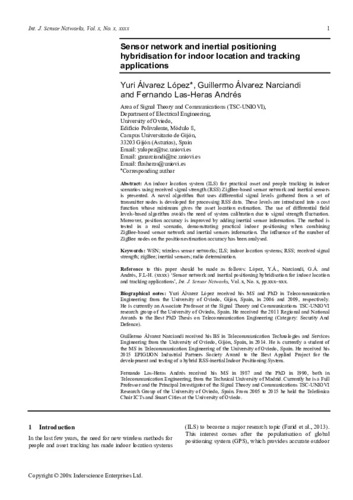Sensor network and inertial positioning hybridisation for indoor location and tracking applications
Subject:
Internet of Things
Tracking
Sensor networks
ZigBee
Publication date:
Editorial:
Inderscience (Geneva, SWITZERLAND)
Publisher version:
Citación:
Descripción física:
Abstract:
An indoor location system (ILS) for practical asset and people tracking in indoor scenarios using received signal strength (RSS) ZigBee-based sensor network and inertial sensors is presented. A novel algorithm that uses differential signal levels gathered from a set of transmitter nodes is developed for processing RSS data. These levels are introduced into a cost function whose minimum gives the asset location estimation. The use of differential field levels-based algorithm avoids the need of system calibration due to signal strength fluctuation. Moreover, position accuracy is improved by adding inertial sensor information. The method is tested in a real scenario, demonstrating practical indoor positioning when combining ZigBee-based sensor network and inertial sensors information. The influence of the number of ZigBee nodes on the position estimation accuracy has been analysed
An indoor location system (ILS) for practical asset and people tracking in indoor scenarios using received signal strength (RSS) ZigBee-based sensor network and inertial sensors is presented. A novel algorithm that uses differential signal levels gathered from a set of transmitter nodes is developed for processing RSS data. These levels are introduced into a cost function whose minimum gives the asset location estimation. The use of differential field levels-based algorithm avoids the need of system calibration due to signal strength fluctuation. Moreover, position accuracy is improved by adding inertial sensor information. The method is tested in a real scenario, demonstrating practical indoor positioning when combining ZigBee-based sensor network and inertial sensors information. The influence of the number of ZigBee nodes on the position estimation accuracy has been analysed
ISSN:
Patrocinado por:
This work has been supported by the ‘ministerio de Economía y Competitividad’ of Spain/European regional development fund (ERDF) under project TEC2014-54005-P (MIRIIEM) and by the ‘Gobierno del principado de asturias’, asturias (Spain), under project GRUPIN14-114
Collections
Files in this item




